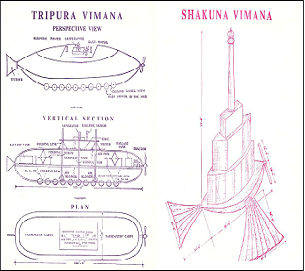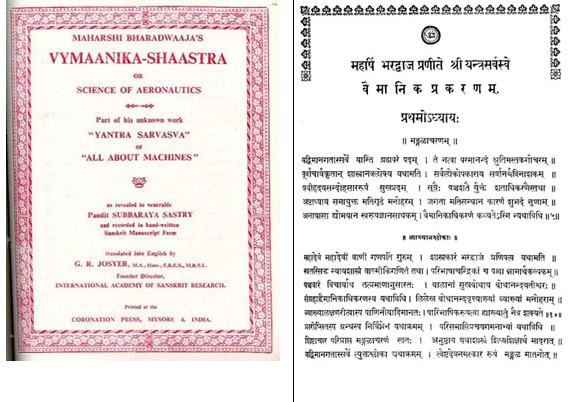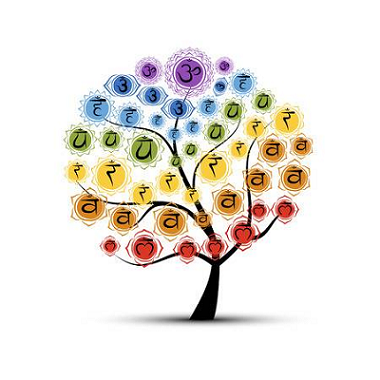Glory of Sanskrit: Past Meets the Future… Sanskrit- A Language Of Ancient Engineers Also!!! By Ms. Shamika Phadke
Introduction:
It is said that the seed for all inventions lies in an inquisitive human mind. Since the dawn of mankind, human beings are always considered the storehouse of innovation. Discoveries and inventions are inherent elements in the evolutionary process and we Indians, have always stood first in bringing out new ideas in various fields, serving the whole world to develop further. Since ancient times, Indians have contributed remarkably in the field of science and literature. It is clearly evident from our ancient scriptures.
Rig veda is the main source of information for various fields of science. The richa (shlokas) in Rig veda are highly scientific and each concept mentioned in it has a vast scope for research. Sanskrit, being the oldest language, encompasses all branches of knowledge. In order to bring out the hidden content, many people are analyzing ‘Rigveda’ and are involved in an in-depth research in the same.
India is a land of numerous great personalities who have stood as an example to the whole world in their own respective arena. Be it the concepts related to our ancient culture and tradition or the highly scientific subjects, Indians have always contributed an exemplary work to the society. Although, we had a wealth of knowledge in many areas, it was not passed on to the next generations properly. So, we had to look forward to modern science to cater to all our needs. In this context, our vision towards modern science is truly a boon to us.
There have been several eminent personalities in our country who were not only great scientists but also understood the importance of our ancient wisdom. Our Ex- President Hon. Dr. A P J Abdul Kalam always motivated the younger generation to dream big. He opined- “Dreams are not those which come while we are sleeping, but dreams are those when you don’t sleep before fulfilling them†. Dr. Kalam envisioned our country to be a super power by 2020. It is the responsibility of the youth of this country to work towards the fulfillment of his dream. Such great people, who have laid a strong foundation for the future generations to pursue their dreams, are an inspiration for them.
In order to achieve those great dreams, the foundation ought to be very strong. Indians have to definitely look back to the treasure of knowledge available to us from the past. Our knowledge of Sanskrit is a divine gift to us which has played a vital role in bridging the gap between the ancient tradition and modern science. We have many ancient Sanskrit treatises which are thoroughly scientific.
Science in Sanskrit treatises:
Sanskrit treatises contain lot of scientific information and we need to study them meticulously. For this purpose, knowledge of Sanskrit is very essential. Ancient Sanskrit literature provides knowledge related to various subjects like Engineering, Medicine, Botany, Mathematics, Zoology, Metallurgy etc.
In olden days, India had many rishis who were an open book of knowledge. ‘Rishi Bharadwaj‘ was one amongst the most revered Sanskrit scholars. He has explained the minutest details of various types of machinery in his treatise- “YantraSarvasvamâ€. In one of the volumes of this magnum opus, he elucidated the subject of aeronautical engineering under the heading of ‘VaimaanikaShastram’ . This grantha reveals the various types of aeroplanes, fuel used in the aircraft, designs of the aircraft etc. It also contains some references about ships and its construction.
The following are some images and video links which can be used as a reference for a further detailed study in this topic.

The precision depicted in the above images prove that our rishis were very proficient in the field of science and technology. Taking these great discoveries forward will help the next generation to fulfill the dream of becoming modern, scientific and a mighty country.
Here are some very useful links which can be used for reference:
https://www.youtube.com/watch?v=Oa6Ab-WW-hw
https://www.youtube.com/watch?v=ugGwXInIo-4
The following details are based on the information shared by Sanskrit Bharti in ‘
Kokan PrantSanskrit Workshop’ held in Mulund on 6 th January 2019.

|
Types of Transport
जले नौकेव यानं सà¥à¤¯à¤¾à¤¦à¥ à¤à¥‚मियानं रथं सà¥à¤®à¥ƒà¤¤à¤®à¥ | आकाशे अगà¥à¤¨à¤¿à¤¯à¤¾à¤¨à¤‚ च वà¥à¤¯à¥‹à¤®à¤¯à¤¾à¤¨à¤‚ तदेव हि ||
{ वराहमिहिरविरचित – à¤à¥ƒà¤—à¥à¤¸à¤‚हिता शà¥à¤²à¥‹à¤• 2 } (6th century C.E) Ships ply on water, ratham (Chariot) on the earth. Vehicles propelled by fire fly in the sky and are called space vehicles. |
|
Types of alloys
अथ नामानि | उषà¥à¤®à¤‚à¤à¤°-उषà¥à¤®à¤ªà¤¾â€“उषà¥à¤®à¤¹à¤¨à¥‹ राजामà¥à¤²à¤¤à¥ƒà¤™à¥à¤µà¥€à¤°à¤¹à¤¾ पञà¥à¤šà¥à¤˜à¥à¤¨à¥‹sगà¥à¤¨à¤¿à¤¤à¥ƒà¤™à¥à¤à¤¾à¤°à¤¹à¤¨à¤¶à¥à¤¶à¥€à¤¤à¤µà¤¹à¤¨à¥‹ गरलाघà¥à¤¨à¤¾à¤®à¥à¤²à¤¹à¤¨à¥‹ विषमà¥à¤à¤° विशलà¥à¤¯à¤•à¥ƒà¤¤à¥ विजमितà¥à¤°à¥‹ वातामितà¥à¤°à¤¶à¥à¤šà¥‡à¤¤à¤¿ |
There are 16 types of alloys for the construction of airplanes made with the help of these metals: Saumaka, Saundalika and Maurtvika. The alloys are: 1. Usmambhara 2. Ushnapa 3. Ushmanaha 4. Raja 5. Amlatrt 6. Viraha 7. Panchaghna 8. Agnitrt 9. Bharahana 10. Shitahana 11. Garalaghna 12. Amlahana 13. Vishambhara 14. Vishalyakrt 15. Vijamitra 16. Vatamitra |
|
Sthambana Yantra Whenever an aircraft is frisked or carried away by strong air current, “Stambhana yantra†or stabilizer is used. This is being described here. A base be prepared about 70 cm, thick from a metal known as “Vakratundaâ€. The diameter may be taken as 1/4 th of the radius of the gyration of the aircraft about a vertical axis passing through the kinetic centre. This base may be anchored to the main frame of the aircraft in eight places or as may be required, through right hand or left hand strong screws which can be operated through toothed gearing and wired ropes or a winch crab. So that this base is secured very firmly to the main body and can be raised or lowered through the mechanical apparatus consisting of screws, gears, columns and wire ropes etc. Yantra Sarvaswa (91-97) |
|
Protection of Aircraft
आकाशपञà¥à¤šà¤®à¤•à¤•à¥à¤·à¥à¤¯à¥‡ विमान: सञà¥à¤šà¤°à¥‡à¤¦à¥à¤¯à¤¦à¤¿ ||५०|| कà¥à¤·à¤¤à¥à¤° कोलाहलजà¥à¤µà¤¾à¤²à¤¾ वेगातॠà¤à¤¸à¥à¤®à¥€à¤•à¥ƒà¤¤à¤‚ à¤à¤µà¥‡à¤¤à¥ | तसà¥à¤®à¤¾à¤¤à¥ ततॠपरिहाराय रौदà¥à¤°à¥€ दरà¥à¤ªà¤£à¤¯à¤¨à¥à¤¤à¥à¤°à¤•à¤®à¥ ||५१|| If the aircraft enters into the fifth layer of the atmosphere due to edges, the aircraft can get damaged. The contrivance called ‘raudra darpana yantra’ offers the protection. |
|
Sabda Kendra Mukha Yantra
शबà¥à¤¦à¥‹à¤¤à¥à¤ªà¤¤à¥à¤¤à¤¿à¤¸à¥à¤¥à¤¾à¤¨à¤à¥‡à¤¦à¤¾: शबà¥à¤¦à¤•à¥‡à¤¨à¥à¤¦à¥à¤°à¤¾ इतीरिता: | तेà¤à¥à¤¯: पà¥à¤°à¤¸à¤¾à¤°à¤£à¤‚ यतà¥à¤¸à¥à¤¯à¤¾à¤¤à¥ शबà¥à¤¦à¤¾à¤¦à¥€à¤¨à¤¾à¤‚ दिकà¥à¤ªà¥à¤°à¤à¥‡à¤¦à¤¤: | तदेव शबà¥à¤¦à¥à¤•à¥‡à¤¨à¥à¤¦à¥à¤°à¤®à¥à¤–सà¥à¤¥à¤¾à¤¨à¤®à¤¿à¤¤à¥€à¤°à¥à¤¯à¤¤à¥‡ | ततà¥à¤°à¤¤à¥à¤¯ – शबà¥à¤¦à¥‹à¤ªà¤¸à¤‚हारारà¥à¤¥à¤‚ तसà¥à¤®à¤¿à¤¨à¥à¤ªà¥à¤°à¤¤à¤¿à¤·à¥à¤ ितमॠ|| तसà¥à¤¯ शà¥à¤°à¤µà¤£à¤®à¤¾à¤¤à¥à¤°à¥‡à¤£ बाधिरà¥à¤¯à¤‚ यनà¥à¤¨à¥ƒà¤£à¤¾à¤‚ à¤à¤µà¥‡à¤¤à¥ | अत: ततà¥à¤ªà¤°à¤¿à¤¹à¤¾à¤°à¤¾à¤¯ शबà¥à¤¦à¥à¤•à¥‡à¤¨à¥à¤¦à¥à¤°à¥à¤®à¥à¤–ाà¤à¤¿à¤§à¤®à¥ | यनà¥à¤¤à¥à¤°à¤‚ संसà¥à¤¥à¤¾à¤ªà¤¯à¥‡à¤¤à¥ यानवामà¤à¤¾à¤—े यथाविधि || -विमानशासà¥à¤¤à¥à¤°à¤®à¥
Loud noises are produced at many points. These are referred as noise centers. Each noise center has to have a noise ‘silencer’. It differs depending upon the levels of noise which may be differed up to three hundred and four levels. This noise can cause permanent damage to ears. Silencers are used to dampen such high noises and are called “ Sabda Kendra Mukha Yantraâ€. |
|
About Ships
न सिनà¥à¤§à¥ गादà¥à¤¯à¤¾à¤°à¥à¤¹à¤¤à¤¿ लोहबनà¥à¤§à¤®à¥ तलà¥à¤²à¥‹à¤¹à¤•à¤¾à¤¨à¥à¤¤à¥ˆ: हियते हि लौहमॠ| विपदà¥à¤¯à¤¤à¥‡ तेन जलेषॠनौका: गà¥à¤£à¥‡à¤¨ बनà¥à¤§à¤‚ निजगाद à¤à¥‹à¤œ: || (यà¥à¤•à¥à¤¤à¤¿à¤•à¤²à¥à¤ªà¤¤à¤°à¥ – निषà¥à¤ªà¤¦à¤¯à¤¾à¤¨à¥‹à¤¦à¥à¤¦à¥‡à¤¶: - शà¥à¤²à¥‹à¤•: - ८८ )
Bhoja says that no iron should be used in joining the planks in the bottom of a ship. This exposes the ship to the influence of magnetic rocks in the sea, brings it within the magnetic field, leading to its sinking. |
Inference:
After having a detailed analysis of the subject, it has been noted that:
· Various types of aircrafts were in use in the ancient times
· Mercury and sunlight were used as a fuel for those aircrafts
It is so astonishing to even imagine the extremely high level of science and technology which prevailed in our country during the earlier days. It is definitely due to our rich literature that institutions like NASA are also interested in the research related to our ancient treatises.
Ancient glory
Apart from “VaimanikaShastram†there are many more references about vimanas in our ancient literature. For instance, in different ‘Puranas’ each deity is associated with a specific vehicle or ‘vahana’. This may be considered as a symbolic representation of various aircrafts mentioned for those deities. Taking references from Vishnu Purana, it has been mentioned that Garuda(eagle) is the vehicle of Lord Vishnu. The physical structure of the bird Garuda,might have inspired the modern scientists to construct a drone which was used in the most recent surgical strike operation as depicted in the movie ‘Uri’.
Further, it is very fascinating to relate this topic of vimana-s to the ’Pushpaka Vimana‘ as mentioned in one of the greatest epics of our country-‘Ramayana’.
In addition, there is a very interesting reference in ‘Meghadoot’ written by the great poet ‘Kalidas’ which indicates the probability of the presence of vimanas in the olden days. In his text, Kalidas had given a clear description of the rivers, mountains etc. while describing the route from ‘RaamgiriAashram’ to ‘AlkaNagari’. This could have been possible only if the person was well versed in the topography of that place or he would have had a vimana which would have been used to visit that place, in order to give an exact description. To support this statement, some geographers visited these places by aeroplane. Surprisingly, they found that the description of these locations was exactly the same as given in the text. Based on this, they opine that Kalidas might have visited these places by aeroplane.
Limitations:
In order to get a thorough knowledge about this subject, high quality research is required to unearth such valuable information from these grantha-s. But it has to be kept in mind that there are also some limitations to it.
- Availability of grantha-s- Unfortunately our ancestors could not preserve all the ancient literary material. Thus, the knowledge got transferred orally from one generation to the other. Only scholars and rishis could study this and the common man was left unaware of this knowledge. Further, the rishis expressed their opinions about their field of expertise in various ancient Sanskrit treatises. As they wanted the granthas to be concise, they used sutras instead of elaborate prose. Also, since they did not want the common man to misuse their knowledge, they used some encoding techniques to express their ideas. This led to the restriction of information being passed on to the common people. It is still a mystery for the common man to decode that precious information because of lack of knowledge of Sanskrit.
· Interpretation of words - Though many Sanskrit scholars are constantly trying to decode these granthas to make it available to the common people, it is practically a very difficult task. In due course of time, the usage of words in Sanskrit language has changed. Ancient Sanskrit was different from what is prevalent today. Many words which were used in old granthas are either obsolete or are used in a different context. The meaning has to be deciphered based on the context in which it is used. Therefore, it is difficult to exactly translate these granthas.
· Authenticity- Even though we get a lot of information about various subjects, it is important to first check the source for its authenticity.
Stepping forward:

Knowledge of Sanskrit not only develops language skills but can prove to be beneficial in all walks of life, be it engineering, medicine or science and technology. It will be helpful for the learners for their research in various fields.
It is the responsibility of our generation to inspire and motivate young learners to chase their dreams of building a modern India, keeping our cultural heritage as a strong base. Nevertheless, one has to constantly keep an eye on what is available in hand and what has to be achieved.



